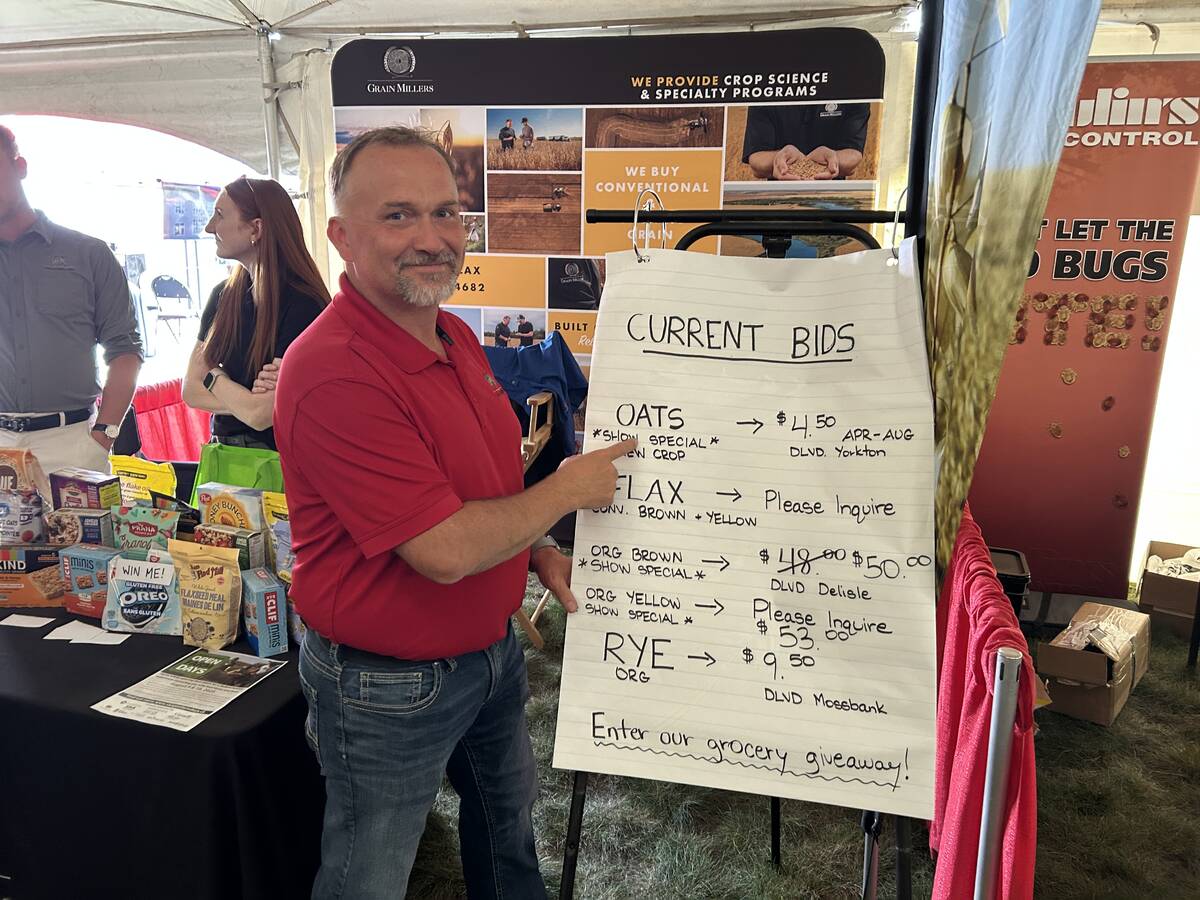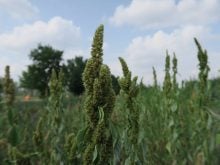Farmers are advised to collect suspected waterhemp plants instead of putting them through the combine
Manitoba Agriculture’s weed specialist urges farmers to watch for waterhemp in their fields during harvest and avoid spreading it with the combine.
“Just do not put those weeds through the combine because … you’re in for a world of hurt once these things take a hold here,” Kim Brown said Sept. 1 while taking suspected waterhemp plants to the Pest Surveillance Initiative Laboratory in Winnipeg for DNA-based identification.
Tall waterhemp (Amaranthus tuberculatus), is a prolific Tier 1 weed under Manitoba’s Noxious Weed Act that can devastate crop yields. Populations resistant to glyphosate have appeared in Manitoba fields. Plants can reach six feet tall and produce up to a million seeds.
Read Also

Canada’s oat crop looks promising
The oat crop looks promising and that’s a good thing because demand is strong.
“I tell guys to keep a big garbage bag on the combine and if you can stop, bag it and get it off the field and find out what it is. Don’t let those weed seeds stay in that field.”
If a waterhemp infestation is too large to hand-pick, cut, bale and then burn the bales, Brown said.
Experienced agronomists can identify waterhemp but it’s sometimes tricky because it can crossbreed with other types of amaranths, including red root pig weed, which is a not a Tier 1 weed.
Waterhemp must be “eradicated without conditions,” says Manitoba Agriculture’s webpage (https://www.gov.mb.ca/agriculture/crops/weeds/) That’s why correct identification is critical.
“It’s important for growers to understand the difference between them [and different amaranth-type weeds] because they have to be managed differently,” said PSI Lab CEO Lee Anne Murphy.
Tests of Manitoba waterhemp show some plants are resistant to groups 9 (glyphosate), two and 14 herbicides.
“A lot of the waterhemp we’re finding is in a soybean field that’s been sprayed twice with glyphosate, and these plants are six feet tall,” said Brown. “The glyphosate didn’t even touch them. So, we know they’re resistant…”
The plants are tested to see what other resistance might be present.
Waterhemp was first found in Manitoba in 2016 and confirmed in 2017. By 2019, it was found in five municipalities. Last year the number increased to eight.
“We’re adding a few more RMs this year.” Brown said, noting they are mostly in the south.
“We have found a lot more of it this year than we have in the past, and that’s concerning.”
This year’s generally hot, dry weather was good for waterhemp, which is one of three Tier 1 amaranthus species found in Manitoba along with Palmer amaranth (Amaranthus palmeri) and smooth pigweed (Amaranthus hybridus).
Other amaranth species in Manitoba, such red root pigweed (Amaranthus retroflexus) and Green/Powell pigweed (Amaranthus powellii), are not Tier 1 noxious weeds.
Of the 69 amaranth tissues tested by the PSI Lab as of Aug. 28, almost three-quarters were waterhemp. While that’s concerning, sampling is not random, Murphy noted.
“We really want to look at the ones that are not easy for agronomists or growers to understand,” she said. “[O]ur sample submissions need to be taken in that context.”
Waterhemp worries Brown most, followed by Palmer amaranth.
“They are more aggressive and more competitive than the smooths and they are also dioecious,” she said. “Dioecious means they have male plants and female plants, which means the [herbicide] resistance spreads that much quicker because a female plant can still be susceptible to different herbicides, but if there’s a male plant… within pollen flow that can fertilize females and then that resistance grows.”
A male and female Palmer amaranth plant was first found in Manitoba in 2021. A male plant was found last year, Brown said.
Herbicide resistant Palmer amaranth in certain southern U.S. states is so pervasive that cotton farmers have hired people to remove it with hoes.
Palmer amaranth and waterhemp have been problematic for years in many American states, including North Dakota, especially in the last 10, Brown said.
The cases found here are believed to have originated in North Dakota and transported via trucks, equipment, flood water and migrating birds.
Brown doesn’t know how many Manitoba acres have waterhemp.
“I think it’s definitely here more than we thought it was, but we are trying to eradicate it when we find it.”
Can it be stopped?
“I sure hope so,” Brown said. “We are trying very hard to contain this. It is not widespread at all. It is in fairly isolated areas so far, so that’s good news. We are working with the farmers. We’re working with agronomists.
“The industry is really on guard for these weeds. I think we can get ahead of this.”
Farmers who spot an unusual looking weed should contact their agronomist or Brown at kim.brown@gov.mb.ca. They can also submit samples to the PSI Lab at mbpestlab.ca/about/.
Brown is thankful the lab, a grower-led facility founded in 2014 and owned by the Manitoba Canola Growers Association, is available to help.
“We were very fortunate to get a very quick turnaround, particularly on the species ID,” she said.
The lab can usually identify an amaranthus weed from a green tissue sample within 24 hours, Murphy said, thanks to DNA-marker tests. It is developing quick tests that Murphy hopes will be available in two years to assess herbicide resistance.
“I’m biased but the fact that the growers continue to invest in this technology for their members, I think is unheralded across Canada for sure.”

















